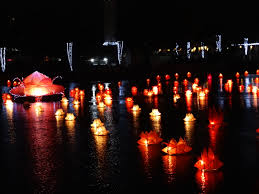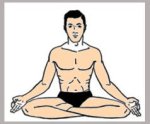If you are like I was and new to Japanese Buddhism, you might not know what a Bon or Obon festival is.
What is an Obon Festival:
 Obon (お盆) or just Bon (盆) is a Japanese Buddhist custom to honor the spirits of one’s ancestors. This Buddhist-Confucian custom has evolved into a family reunion holiday during which people return to ancestral family places and visit and clean their ancestors’ graves, and when the spirits of ancestors are supposed to revisit the household altars. It has been celebrated in Japan for more than 500 years and traditionally includes a dance, known as Bon-Odori.
Obon (お盆) or just Bon (盆) is a Japanese Buddhist custom to honor the spirits of one’s ancestors. This Buddhist-Confucian custom has evolved into a family reunion holiday during which people return to ancestral family places and visit and clean their ancestors’ graves, and when the spirits of ancestors are supposed to revisit the household altars. It has been celebrated in Japan for more than 500 years and traditionally includes a dance, known as Bon-Odori.
Obon is a shortened form of Ullambana (Japanese: 于蘭盆會 or 盂蘭盆會, urabon’e). It is Sanskrit for “hanging upside down” and implies great suffering. The Japanese believe they should ameliorate the suffering of the “Urabanna”.
Bon Odori originates from the story of Maha Maudgalyayana (Mokuren), a disciple of the Buddha, who used his supernatural powers to look upon his deceased mother. He discovered she had fallen into the Realm of Hungry Ghosts and was suffering. Greatly disturbed, he went to the Buddha and asked how he could release his mother from this realm. Buddha instructed him to make offerings to the many Buddhist monks who had just completed their summer retreat, on the fifteenth day of the seventh month. The disciple did this and, thus, saw his mother’s release. He also began to see the true nature of her past selflessness and the many sacrifices that she had made for him. The disciple, happy because of his mother’s release and grateful for his mother’s kindness, danced with joy. From this dance of joy comes Bon Odori or “Bon Dance”, a time in which ancestors and their sacrifices are remembered and appreciated.
What, we are doing:
You might see the images above and might be a little confused. You might be asking, aren’t those little boats normally reserved for Hina Matsuri? Well yes, typically seen during The Doll Festival, or momo-no-sekku (“peach blossom fete”). Ceremonial dolls – often valuable family heirlooms – are displayed in the best room in the house. Such dolls, clothed in ancient formal costumes, are often bought on the birth of a girl, or given by relatives or friends. In some areas, the festival maintains its original theme of exorcism: symbolic dolls are loaded up in boats and sent out to sea, with the prayer that all bad luck, impurities, and evil spirits should be transferred from girls to the dolls which are floating away.
But as the Dalai Lama (yes Tibetan references again) said. We should not learn about Buddhism to become Buddhists, but to become better at what we already are. Since the history of Buddhism is filled with examples of how tradition adapts with the local culture, and attachments lead to suffering. I figured, since my “ancestors” graves aren’t in Japanese tradition and actually spread across the whole country, the best thing I could do was adapt the boats seen during to doll festival to represent the spirits of my ancestors, heading out before me as they have done, into the next incarnation. To honor their sacrifices that lead to my existence today.
“Having recalled that such and such persons, who used to be our relatives and friends, had kindly given this to us or had kindly done this to us, such relatives and friends should perform the rites for the deceased. They should not weep or lament with grief, since to do so would do nothing good for the deceased, who will remain as they are.
The offerings that you have done, that have been well established in the Sangha, will go to benethe deceased for a long time within the range of possibility (in each case). A great merit you have done in performing your duties as their relatives, in worshipping the deceased through this fruitful kind of worship and in strengthening the Bhikkhus in doing so.”




 Firstly before I get into today’s post I want to you the reader to know that what I am about to say, although it may ruffle feathers or raise some hackles, this posting comes from a place of love, understanding and compassion towards all life.
Firstly before I get into today’s post I want to you the reader to know that what I am about to say, although it may ruffle feathers or raise some hackles, this posting comes from a place of love, understanding and compassion towards all life. Karma, when it comes down to it, is basically the simple process of cause and effect. Our suffering for the effect is a result of our attachments. We must not become blinded by what we have lost so much so that we forget what we still have. Sometimes our suffering leads to more bad Karma based on how we chose to react to said effects. Some times too we have to deal with OPK (Other People’s Karma), but we suffer less when we are prepared to lose everything, lesser still when we have little to begin with.
Karma, when it comes down to it, is basically the simple process of cause and effect. Our suffering for the effect is a result of our attachments. We must not become blinded by what we have lost so much so that we forget what we still have. Sometimes our suffering leads to more bad Karma based on how we chose to react to said effects. Some times too we have to deal with OPK (Other People’s Karma), but we suffer less when we are prepared to lose everything, lesser still when we have little to begin with.
 This year has turned out to be the year that everything changes, for everyone I suppose. Elections and what not here in the United States. For me however there have been plenty of personal life changes. For those of you who don’t know I am a disabled Veteran of the United States Army. That’s right this peace loving hippie was once a soldier *chuckles*.
This year has turned out to be the year that everything changes, for everyone I suppose. Elections and what not here in the United States. For me however there have been plenty of personal life changes. For those of you who don’t know I am a disabled Veteran of the United States Army. That’s right this peace loving hippie was once a soldier *chuckles*.
Recent Comments